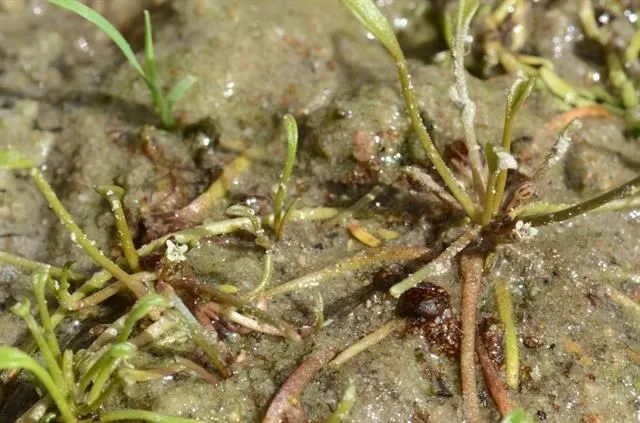
Author: L.
Bibliography: Sp. Pl.: 631 (1753)
Year: 1753
Status: accepted
Rank: species
Genus: Limosella
Vegetable: False
Observations: Subarctic & Temp. Northern Hemisphere to Mexico, Ecuador to Peru
Mudwort, scientifically known as Limosella aquatica, is an intriguing aquatic plant that thrives in a variety of environments. Described initially by the renowned botanist Carl Linnaeus in his work “Species Plantarum” published in 1753, Mudwort is a member of the Plantaginaceae family. Despite its diminutive size, this plant holds a significant presence across a wide geographical range.
Mudwort is primarily found in subarctic and temperate regions of the Northern Hemisphere. Its habitat extends as far north as these colder climates and stretches all the way down to the southern regions of Mexico. Additionally, in South America, Mudwort’s presence has been recorded from Ecuador all the way to Peru, showcasing its adaptability to diverse environmental conditions.
This perennial herb typically occupies muddy shores of fresh water bodies, such as lakes and rivers, where it forms dense mats of greenery. Its creeping stems and small, round leaves contribute to its unique, low-lying appearance. The roots of Mudwort are well-adapted to anchoring in soft, silty substrates, making it an ideal plant for stabilizing shorelines and preventing soil erosion.
Mudwort’s flowers are another point of interest. While not particularly showy, the small, white to pale pink blooms emerge close to the ground, often partially submerged or resting just above the water surface. These discreet flowers play a crucial role in the reproductive cycle of the plant, propagating through both seeds and vegetative means.
Ecologically, Mudwort serves important functions in its environment. It provides habitat and food for various aquatic and semi-aquatic organisms, including invertebrates and small amphibians. The plant’s ability to grow in nutrient-poor conditions also makes it a valuable species for studying the ecological dynamics of wetland habitats.
In summary, Limosella aquatica, or Mudwort, is a resilient and geographically widespread plant notable for its adaptability in diverse temperate and subarctic conditions. Its unassuming appearance belies its ecological value and the role it plays in maintaining healthy aquatic ecosystems. As an early subject of botanical study, Mudwort continues to be a plant of interest for both its historical significance and environmental contributions.
Dan: dyndurt
Deu: gewöhnlicher schlammling, gewöhnliches schlammkraut, schlammkraut, schlammling
Eng: water mudwort, awl-leaf mudwort, awlleaf mudwort, mudwort, northern mudwort, common mudwort, owyhee mudwort, awl-leaved mudwort, broad-leaved mudwort, stemless mudwort
Fra: limoselle, limoselle aquatique, limoselle acaule
Nld: slijkgroen
Nor: vesle-gro
Swe: ävjebrodd, dyört
Sme: mohteurttas
Kor: deung-po-pul
Cym: lleidlys
En: Mudwort, Water mudwort, Awl-leaved Mudwort, Awl-Leaf Mudwort, Awl leaf mudwort, Northern mudwort, Awlleaf mudwort, Common Mudwort, Owyhee mudwort, Broad-leaved mudwort, Stemless mudwort
Ar: وحلية مائية
Be: Лужайнік вадзяны
Zh: 水茫草
Cs: Blatěnka vodní
Da: Dyndurt
Nl: Slijkgroen
Et: Harilik nõgilillik
Fi: Mutayrtti, Pohjanmutayrtti
Fr: Limoselle Aquatique, Limoselle, Limoselle acaule, Limoselle australe
De: Schlammglöckchen, Schlammkraut, Schlammling, Wasserschlammkraut, Gewöhnliches Schlammkraut, Gewöhnlicher Schlammling
It: Limosella
Ko: Deung-po-pul
Lt: Vandeninė dumblenė
Se: Mohteurttas
No: Vesle-gro
Fa: گل لای
Pl: Namulnik brzegowy
Ru: Лужница водяная
Sv: Ävjebrodd, Dyört
Uk: Мулянка водяна
Cy: Lleidlys
Taken Mar 24, 2021 by donalddavesne (cc-by-sa)
Taken Jan 1, 1900 by EOL − Encyclopedia of Life (cc-by-nc)
Taken Dec 30, 2020 by Tamanna tamanna Bhalla (cc-by-sa)
Taken Jul 26, 2022 by jacques maréchal (cc-by-sa)
Taken Oct 5, 2019 by Ria Kamps (cc-by-sa)
Taken Sep 15, 2005 by Photoflora – Jean-Luc TASSET (©)
Taken Sep 15, 2004 by Photoflora – Jean-Luc TASSET (©)
Taken Sep 23, 2018 by K. O. Dudas (cc-by-sa)
Taken Jan 1, 1900 by EOL − Encyclopedia of Life (cc-by-nc)
Taken Jan 1, 1900 by EOL − Encyclopedia of Life (cc-by-nc)
Taken Jan 1, 1900 by EOL − Encyclopedia of Life (cc-by-nc)
Taken Jan 1, 1900 by EOL − Encyclopedia of Life (cc-by-nc)
Taken Jan 1, 1900 by EOL − Encyclopedia of Life (cc-by-nc)
Taken Sep 15, 2004 by Photoflora – Benoit BOCK (©)
Taken May 15, 2004 by Photoflora – Benoit BOCK (©)
Taken May 15, 2004 by Photoflora – Benoit BOCK (©)
Taken Jan 1, 1970 by Photoflora – L’Abbé COSTE (©)
Taken Jul 31, 1851 by Tela Botanica − Herbier PONTARLIER-MARICHAL (cc-by-sa)
Taken Sep 15, 2005 by Photoflora – Benoit BOCK (©)
Taken Jan 1, 1900 by EOL − Encyclopedia of Life (cc-by-nc)
Taken Jan 1, 1900 by EOL − Encyclopedia of Life (cc-by-nc)
Taken Jan 1, 1900 by EOL − Encyclopedia of Life (cc-by-nc)
© copyright of the Board of Trustees of the Royal Botanic Gardens, Kew.
© copyright of the Board of Trustees of the Royal Botanic Gardens, Kew.
© copyright of the Board of Trustees of the Royal Botanic Gardens, Kew.
Growth habit: Forb/herb
Ph maximum: 5.5
Ph minimum: 5.0
Light: 8
Atmospheric humidity: 8
Soil nutriments: 4
Family: Myrtaceae Author: (F.Muell.) K.D.Hill & L.A.S.Johnson Bibliography: Telopea 6: 402 (1995) Year: 1995 Status:…
Family: Rubiaceae Author: Pierre ex A.Froehner Bibliography: Notizbl. Bot. Gart. Berlin-Dahlem 1: 237 (1897) Year:…
Family: Sapindaceae Author: Koidz. Bibliography: J. Coll. Sci. Imp. Univ. Tokyo 32(1): 38 (1911) Year:…
Family: Asteraceae Author: A.Gray Bibliography: Pacif. Railr. Rep.: 107 (1857) Year: 1857 Status: accepted Rank:…
Family: Fabaceae Author: Medik. Bibliography: Vorles. Churpfälz. Phys.-Ökon. Ges. 2: 398 (1787) Year: 1787 Status:…
Family: Aspleniaceae Author: (Cav.) Alston Bibliography: Bull. Misc. Inform. Kew 1932: 309 (1932) Year: 1932…